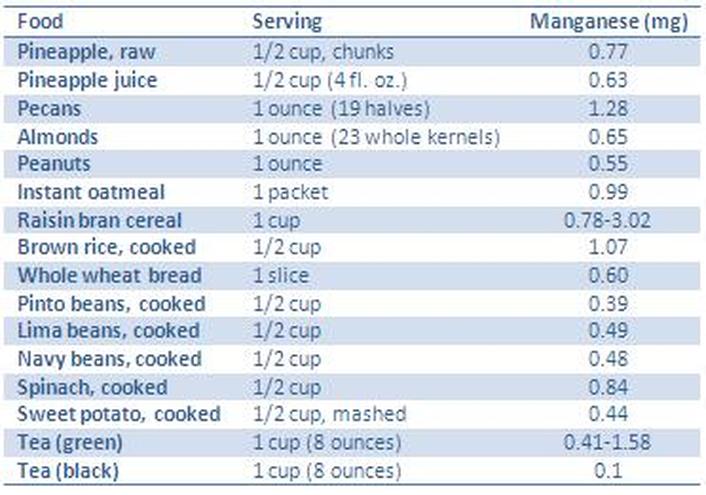
Manganese, a trace mineral that participates in many enzyme systems in the body, was first considered an essential nutrient in 1931. Researchers discovered that experimental animals fed a diet deficient in manganese demonstrated poor growth and impaired reproduction. Manganese is found widely in nature, but occurs only in trace amounts in human tissues. The human body contains a total of 15-20 milligrams of manganese, most of which is located in the bones, with the remainder found in the kidneys, liver, pancreas, pituitary glands, and adrenal glands.
What is the function of manganese?
In the human body, manganese functions as an enzyme activator and as a component of metalloenzymes (an enzyme that contains a metal ion in its structure).
Enzyme activator
Manganese activates the enzymes responsible for the utilization of several key nutrients including biotin, thiamin, ascorbic acid, and choline. It is a catalyst in the synthesis of fatty acids and cholesterol, facilitates protein and carbohydrate metabolism, and may also participate in the production of sex hormones and maintaining reproductive health.
In addition, manganese activates the enzymes known as glycolsyltranserferases and xylosyltransferases, which are important in the formation of bone. It has also been theorized that manganese is involved in the production of the thyroid hormone known as thyroxine and in maintaining the health of nerve tissue.
A component of metalloenzymes
Manganese has additional functions as a constituent of the following metalloenzymes:
- Arginase, the enzyme in the liver responsible for creating urea, a component of urine
- Glutamine synthetase, an enzyme involved in the synthesis of glutamine
- Phosphoenolpyruvate decarboxylase, an enzyme that participates in the metabolism of blood sugar
- Manganese-dependent superoxide dismutase, an enzyme with antioxidant activity that protects tissues from the damaging effects of free radicals.This enzyme is found exclusively inside the body's mitochondria (oxygen-based energy factories inside most of our cells).
What health conditions require special emphasis on manganese?
Manganese may play a role in the prevention and/or treatment of the following medical conditions:
- Allergies
- Asthma
- Diabetes
- Epilepsy
- Heart disease
- Learning disabilities
- Multiple sclerosis
- Myasthenia gravis
- Osteoporosis
- Premenstrual syndrome
- Rheumatoid arthritis
- Schizophrenics
- Sprains and strains
Food Sources
What foods provide manganese?
Excellent food sources of manganese include hemp seeds, mustard greens, kale, chard, raspberries, pineapple, strawberries, quinoa, romaine lettuce, collard greens, spinach, pecans, almonds, garlic, summer squash, grapes, turnip greens, eggplant, brown rice, blackstrap molasses, maple syrup, cloves, cinnamon(Ceylon), thyme, black pepper, and turmeric.
Very good sources of manganese include leeks, broccoli, beets, cranberries.
Good sources of manganese include cucumber, peppermint, millet, barley, figs, bananas, kiwifruit, carrots, cashews, bell peppers, and onions.
